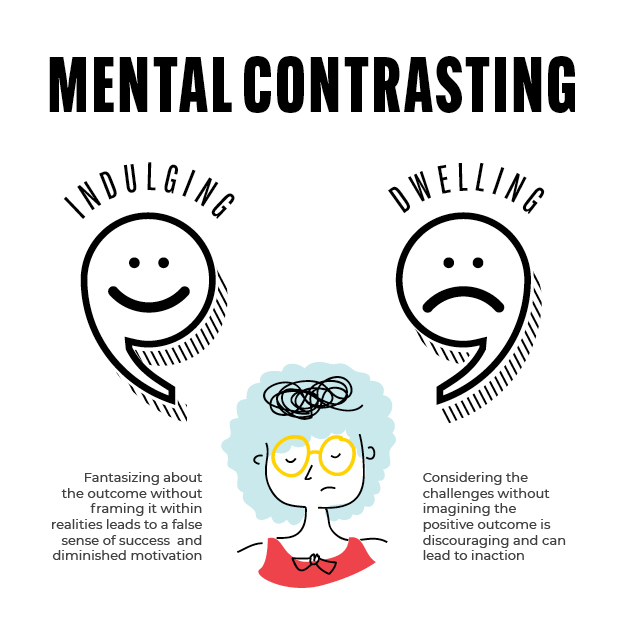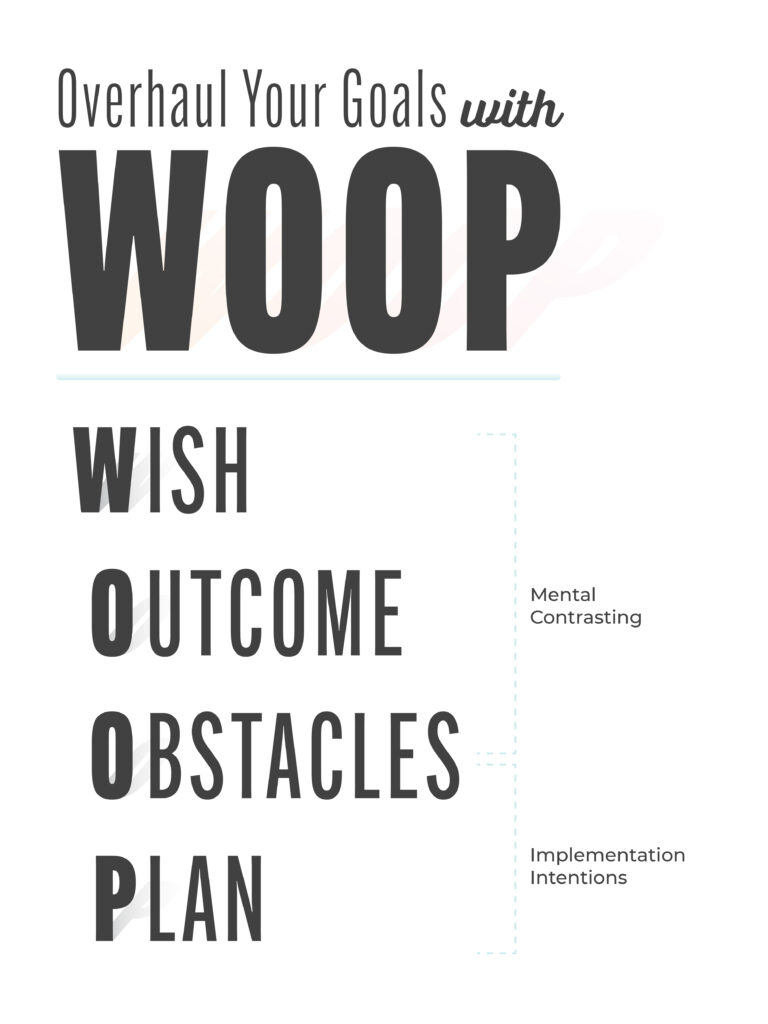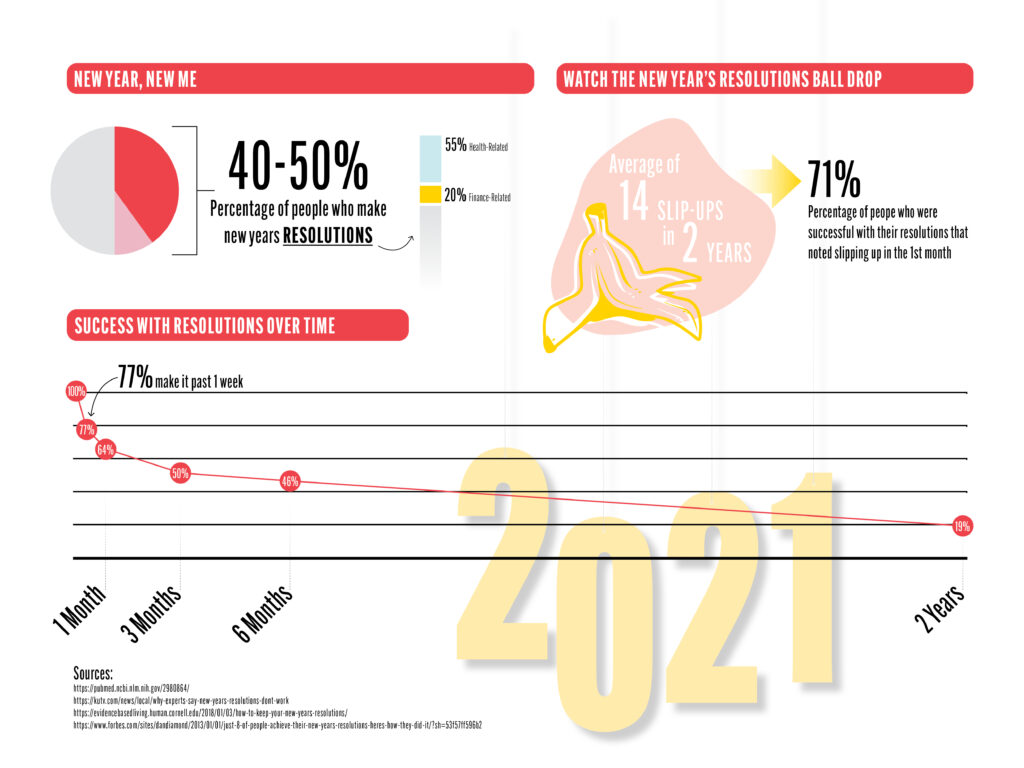We’ve all done it. As the new year approaches, we set resolutions with every intention of succeeding, only to let sight of our goals fade slowly (or immediately, for some). And yet, we repeat the process every time. The fresh start effect of the new year encourages us overlook failed resolutions of years past. So what if we didn’t succeed last year, this year will be the year. New year, new us, right?
If they say the definition of insanity is taking the same course of action yet expecting different results, then new year’s resolutions are proof that we’ve all totally lost it.
You Say You Want a Resolution?
The problem is not with the resolutions themselves. In fact, resolutions are shown to encourage real results. Compared with people who simply wanted to improve, resolution-setters are 10 times as likely to make a positive change according to researchers at the University of Scranton.
If resolutions are at least partly effective, why are so many resolutions abandoned entirely? And why do we struggle to follow through?
Perhaps we’re a little over zealous. Last year, for example, I spent weeks leading up to January 1st truly contemplating the life I wanted. I had just lost my father, and realized I was just half his age. Suddenly, I was confronted with the brevity of life, and the realization that, even at 32, I very well could be passed my “mid-life.” Long story short, I spent a great deal of time outlining my ideal year (in fact, I set out a multi-year plan).
Enter 2020, the year I was supposed to thrive. Instead, I merely survived. Alas, just a few months in, the pandemic began to directly affect my plans. Needless to say, I completely altered course and probably couldn’t tell you today what those resolutions even were. I can’t even blame the pandemic, though. My 2019 resolutions are equally vague in my memory, as are all the resolutions that preceded them.
Failed Resolutions—You’re Not Alone!
I doubt I’m alone with my unfulfilled resolutions—in fact, I know it. On the whole, resolutions are notorious for being abandoned (which is indeed supported by empirical evidence). Research conducted by the University of Scranton found that 23% of resolution-setters will give up after a week, and more than 80% of resolution-setters fail at meeting their goal by year two.
Better Resolutions for 2021
But don’t ditch the resolution altogether. Despite abysmal success rates, resolutions have the potential to encourage positive results. The problem with resolutions is not in the resolution itself. Rather, the problem is in how we define our goals and plan (or fail to plan) how to achieve them.
As it turns out, there’s a trick to setting goals in a way that prepares us for success. To follow through and actually succeed with resolutions, all we have to do is employ a scientifically-proven goal-setting method known as the W.O.O.P technique.
Set Better Goals
Let’s be real here. We probably set last year’s resolution goals a little too high, forgot to give our goal bounds, and didn’t account for the hurdles.
Achieving a goal starts with clearly defining the desire. It’s important that we use as much specificity as possible. For instance, let’s say my goal is to be healthier. That’s pretty vague. Instead, I would be more effective if I resolved to eat home-cooked dinners for 6 nights every week, or to get 30 minutes of exercise each of three days a week. Specifying goals with quantitative precision helps generate a better strategy to meet that goal.
Create a Goal-Achievement Plan
I often hear people praise the power of positive thinking. The argument goes like this: positive thoughts are a powerful way to attract or manifest the good things you want in life. Essentially, what we think about, we bring about.
However, while it’s important to believe that we are capable and deserving of good things, merely thinking about what we desire is insufficient to produce that desire. Actually, some now argue that the positive thinking mindset may do more harm than good (for example, see Barbara Ehrenreich’s book). While positive thinking may be effective at keeping our spirits high and optimistic, this can actually make us feel so good about our prospects that we get some of the same neurological benefits we’d receive if we actually achieved our goal. Thus, we become complacent as we develop a false sense of success and a diminished motivation to take action.
Furthermore, positive thinking can do more harm than good by presenting a vision of success that lacks the backdrop of reality. On its own, positive visualization inadequately prepares us with the tools, mindset, or tactics necessary to achieve our goals. Without such, our deceptive sense of success has become false hope syndrome.
On the flipside, dwelling exclusively on the challenges before even starting can be discouraging. It’s easy to get weighed down by the prospect of impending challenges, which is perhaps a significant reason why over 20% of resolution-setters give up after just a single week.
It’s not that we need to employ either positive thinking or pessimistic thinking (each, on their own, leading to inaction); we need both. We need the mental contrasting of the desired positive outcome against the challenges of reality. We need to both INDULGE in positive visualization, but also DWELL on the obstacles before us if we want to get results. This is the idea of the W.O.O.P. technique.

The WOOP Technique
Coined by Dr. Gabriele Oettingen, W.O.O.P. stands for Wish, Outcome, Obstacles, and Plan.
This empirically-validated goal-setting framework involves mental contrasting of desired positive outcomes with anticipated obstacles to inform the necessary implementation intentions. (In scientific lingo, W.O.O.P. is another way of describing the Mental Contrasting with Implementation Intention (MCII) technique.)
Here’s what’s involved:

Wish
Identity the goal with as much specificity as possible. The goal should be challenging, but achievable.
Outcome
Imagine the best possible outcome of achieving this goal. Really experience this in the mind. *Always think about the outcome before moving on to obstacles*
Obstacles
Consider what stands in the way of achieving this goal. Specifically, we should think about what within us might prevent success. Be honest! Identifying the obstacles will help us discover the means to overcome them.
Plan
Finally, an implementation plan shape the goal around anticipated obstacles and outlines the instruments needed to overcome challenges. An if-then plan establishes how to respond when faced with each identified obstacle.
W.O.O.P is a simple yet incredibly effective tactic. Hear Dr. Oettingen walk through the process step-by-step.
The W.O.O.P. technique illuminates a path to success. By knowing what we want (WISH), why it’s valuable (OUTCOME), and what stands in our way (OBSTACLE), we can assign the behaviors or attitudes we’d like to demonstrate as an automatic response that intervenes when faced with such obstacles (PLAN). Essentially, these automatic processes do all the work! Obstacles will trigger non-conscious, automatic reactions to help keep our resolutions on track.
The effectiveness of the W.O.O.P. technique is empirically-validated. One of Oettingen’s studies, for instance, found that participants who employed the W.O.O.P. technique were twice as effective at taking goal-directed action and generating positive change when compared with a group of individuals who desired change but did not employ the technique. This is especially true when it comes to difficult goals, discovered in another study which revealed that participants were three times as likely to achieve difficult goals when they set implementation intentions (Gollwitzer & Brandstatter, 1997).
It should be noted that the value of the W.O.O.P. technique extends well beyond new year’s resolutions. W.O.O.P. can be applied when tackling chores, implementing work projects, and completing both short- and long-term assignments. Apply the technique to any goal, any time of year. Or, employ W.O.O.P. to determine if something is worth a pursuit at all. For instance, it can help you understand when you might delegate, postpone, or let go of a task entirely if the obstacles are too great.
Relevance in Urban Design & Planning
In my work as an urban designer, I create implementation plans to help my clients realize and put into place the recommendations I’ve presented. Such implementation plans consider all the moving parts and pieces, the various hurdles, and the necessary resources. The W.O.O.P. method seems incredibly familiar to me and only emphasizes the importance of considering obstacles in the way so communities can be equipped and ready to follow through.
Ready, Set, WOOP
W.O.O.P.-ing is the difference between reaching a goal or ending up among the 80% who fail to achieve their resolutions.
So go on and W.O.O.P. to the New Year! Download this free W.O.O.P. Worksheet to set your resolution and set you up for success! —>

And as a final word of encouragement, don’t give up after a mistake, either. When it comes to resolutions, it’s incredibly common to have a slip-up in the first month. Successful resolvers recognize their slips as momentary lapses in the resolution and not complete failures.

More Stuff!
Learn more about WOOP at Woopmylife.org
Character Lab WOOP from Character Lab on Vimeo:
More Resources:
https://evidencebasedliving.human.cornell.edu/2018/01/03/how-to-keep-your-new-years-resolutions/

